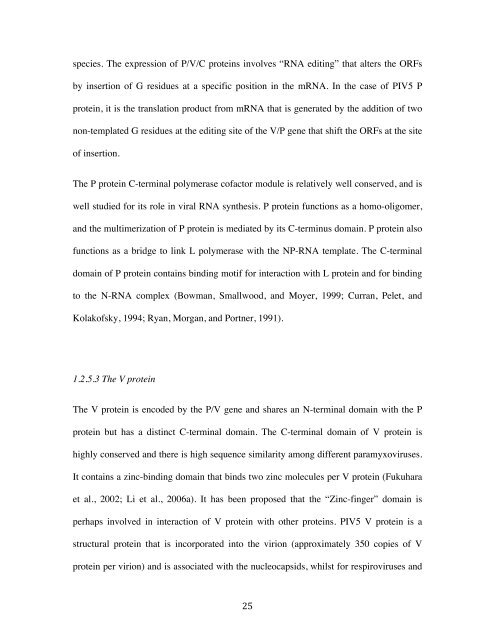Han Xiao PhD thesis - Research@StAndrews:FullText - University of ...
Han Xiao PhD thesis - Research@StAndrews:FullText - University of ...
Han Xiao PhD thesis - Research@StAndrews:FullText - University of ...
You also want an ePaper? Increase the reach of your titles
YUMPU automatically turns print PDFs into web optimized ePapers that Google loves.
species. The expression <strong>of</strong> P/V/C proteins involves “RNA editing” that alters the ORFs<br />
by insertion <strong>of</strong> G residues at a specific position in the mRNA. In the case <strong>of</strong> PIV5 P<br />
protein, it is the translation product from mRNA that is generated by the addition <strong>of</strong> two<br />
non-templated G residues at the editing site <strong>of</strong> the V/P gene that shift the ORFs at the site<br />
<strong>of</strong> insertion.<br />
The P protein C-terminal polymerase c<strong>of</strong>actor module is relatively well conserved, and is<br />
well studied for its role in viral RNA syn<strong>thesis</strong>. P protein functions as a homo-oligomer,<br />
and the multimerization <strong>of</strong> P protein is mediated by its C-terminus domain. P protein also<br />
functions as a bridge to link L polymerase with the NP-RNA template. The C-terminal<br />
domain <strong>of</strong> P protein contains binding motif for interaction with L protein and for binding<br />
to the N-RNA complex (Bowman, Smallwood, and Moyer, 1999; Curran, Pelet, and<br />
Kolak<strong>of</strong>sky, 1994; Ryan, Morgan, and Portner, 1991).<br />
1.2.5.3 The V protein<br />
The V protein is encoded by the P/V gene and shares an N-terminal domain with the P<br />
protein but has a distinct C-terminal domain. The C-terminal domain <strong>of</strong> V protein is<br />
highly conserved and there is high sequence similarity among different paramyxoviruses.<br />
It contains a zinc-binding domain that binds two zinc molecules per V protein (Fukuhara<br />
et al., 2002; Li et al., 2006a). It has been proposed that the “Zinc-finger” domain is<br />
perhaps involved in interaction <strong>of</strong> V protein with other proteins. PIV5 V protein is a<br />
structural protein that is incorporated into the virion (approximately 350 copies <strong>of</strong> V<br />
protein per virion) and is associated with the nucleocapsids, whilst for respiroviruses and<br />
<br />
25
















